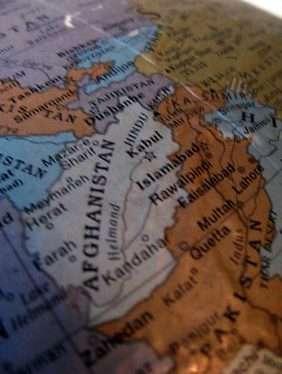
On August 15, 2021, two weeks before the planned withdrawal of all American troops from Afghanistan, the Taliban took over the country. Days before the withdrawal, the Department of Defense released the names of 13 U.S. Service Members killed at the Kabul airport in a suicide bombing. These events occurred a few weeks before the 20th anniversary of the 9-11 attacks, and as powerful emotions and memories collide with current events, many students were learning about the history of the Afghan conflict for the first time.
The Taliban is an Islamic nationalist movement founded in the early 1990s that
ruled in most of Afghanistan from 1996 to October 2001. When the Taliban seized control and killed the Afghan president in September 1996, it instituted strict interpretations of the Quran and practiced merciless policies in order to subscribe to these values. The Taliban provided a safe haven for the terrorist group, al-Qa’ida, until the 9-11 attacks triggered the Afghanistan War. During the American campaign, the Taliban was removed from power and retreated. After the removal, the United States began to assist Afghanistan reconstruction efforts, and supported the institution of a new government.
The war continued with increasing casualties on both sides as the Taliban attacked Afghanistan from within. During former president Barack Obama’s terms, withdrawal from Afghanistan was discussed, but the capabilities of the Afghan government were questioned. In more recent years, former president Donald Trump determined that withdrawal from Afghanistan would be determined by “conditions on the ground” and at one point, called off the ongoing peace talks with the Taliban.
In 2020, the United States signed a deal with the Taliban, and intra-Afghan peace
talks began while actions to withdraw U.S. troops from the country started that November. When President Joe Biden took office, he pledged to withdraw all troops by September 11, 2021. During his remarks on July 8 about the withdrawal, Biden responded to a question raised by the press in regards to trusting the Taliban with “Do I trust the Taliban? No. But I trust the capacity of the Afghan military, who is better trained, better equipped, and more competent in terms of conducting war.”
By August 15, 2021, the Afghan president, Ashraf Ghani, fled Kabul, the capitol of Afghanistan.
Because the Taliban faced little resistance in August 2021, the organization regained control of Afghanistan, taking the capital, Kabul, and capturing all but two Afghan provinces. Throughout the Taliban offensive, thousands of Afghans who had worked with the United States fled the country. Many in the United States have since questioned the timing and the planning of the withdrawal. Efforts were begun, however, to assist those refugees.
One example of this effort is right in the Fox Valley area.
Col. Ellen Ball, who typically works in the Early Childhood Education program in Batavia,
was assigned to be the Emergency Preparedness Liaison Officer for the state of Indiana and to work as the acting Defense Coordinating Officer for an Afghan refugee camp in Gary, IN. She agreed to an interview in order to provide more information.
“We’re trying to make communities here on the base,” she said, regarding the Afghan refugees. “We have over 1000 kids here four and under. 40% of the population is 14 and under. So there’s a lot of kids, a lot of families.”
The Afghan population at the base does not originate from one specific region or
group in the country. As Ball phrases it, “It’s kind of like taking a little city from Afghanistan with a mix of populations, from rural to city folks. Take them all, 7,000 of them, and place them in the middle of southern Indiana.”
As the resettlement of Afghan people takes place in Indiana, students at East had the opportunity to learn more about the current events and the history of American/Afghan affairs. Mrs. Valentine, an Honors Civics and Contemporary World Issues teacher, took time to address the crisis within her classroom.
“I’m continuously using Afghanistan as an example. Where is it happening? Why is it happening? And then, why care?”
When asked if her students have background knowledge on the decades long conflict, she responded, “No. And I think that’s something my age group takes for granted.”
To her, 9/11 is a visceral event that made a big impact; however, since most students were born after 2001, they have only known the post 9-11 world.
Although current high school students are the post 9-11 generation, interest level among them was high.
“My students understand that they have very little background knowledge in the entire conflict, and they have a lot of questions,” says Mrs. Valentine.
Carly Burnet is a senior at East and an AP Government student who was asked how her class took on the topic. “Our class briefly discussed it the day after it was announced on the news, but we haven’t talked about it since then,” she says. Burnet expressed her wish that the class was discussing the events more.
“I’m very interested in learning more of the details surrounding the situation, and I
think my class would be the perfect place to do that.”
UPDATES SINCE SEPTEMBER
The U.S. Department of State released an update on the Afghan refugees here in the U.S. on December 13, 2021. According to the State Department, over 74,000 refugees have been welcomed to the United States. These people are spread between current transit to the States, military bases, and local communities. Over 40% of these refugees are eligible for Special Immigration Visas, a program that provides visas to those who worked with the US Armed Forces and their immediate families. The Biden Administration states that it has surged resources which allowed for accelerated processing of SIVs.
The last official statement made by the White House in regards to the Afghan conflict was released on October 28, 2021.
Over the course of his presidency, Biden’s approval rating has seen significant changes since the beginning of his term. According to FiveThirtyEight, an online source which calculates the approval ratings of presidents over their term, Biden had a 53% approval rating and 37% disapproval rating in the first days of his term. Approval peaked at 55% in late May, but once August arrived, his ratings plummeted. By August 30, 2021, Biden’s disapproval rating was 47.5% while approval ratings hit 47.2%. Approval continuously diminished until the 50.7% disapproval/42.9% approval of December 14, 2021.
The decline in approval for the Biden administration has been linked to the withdrawal from Afghanistan. In the podcast, “Can He Do That?” produced by the Washington Post, White House reporter Ashley Parker stated her opinion on why this was occurring.
“President Biden ran on the promise of restoring normalcy to the United States and to the office of the presidency. But I actually think the first place he really undercut that was the way in which he withdrew from Afghanistan at the end of the summer.”
Although Biden’s approval ratings have taken a hit and many analysts continue to debate the U.S. policies, Afghanistan is facing far worse challenges after the withdrawal. Between sanctions, frozen aid, a drought, and the pandemic, the country is floundering. The Afghan economy has been frozen which has caused extreme displacement, food shortages, and an imminent threat of starvation. Currently the World Food Programme sought extra funds in order to combat this issue. According to the WFP, “For the first time, urban residents are suffering from food insecurity at similar rates to rural communities, with the latter ravaged by drought twice in the past three years.” In addition, the UNHCR launched a campaign for Afghanistan and sent a spokesperson to address the issue. Baber Baloch addressed the United Nations after his return from Kabul stating that “people don’t have enough to eat, and it’s very visible.”
Between food shortages and lack of shelter against bitter cold, it is anticipated that thousands of Afghan people will suffer during this winter.
Aside from the humanitarian crisis in regards to food, another major concern of the public was the rights of Afghan women under the Taliban rule. Historically, the Taliban had placed severe restrictions on women and their freedoms. Afghan women were no longer allowed to work and attend school. On December 3, 2021, the Taliban released a decree which bans forced marriage in the country. In a separate debriefing of the UNHRC, Nada Al-Nashif acknowledged the decree as an important step, but “it does not make clear a minimum age for marriage, nor refer to any wider women and girls’ rights to education, to work, to freedom of movement, or to participate in public life.”
Under the current regime, these limitations have returned and many women have been forced to leave their jobs and lose a source of income. This has further exacerbated the failing economy and the number of Afghans facing food and housing crises. Students have also been put at risk as Al-Nashif reports, “Some 4.2 million young Afghans are already out of school, 60 percent of them girls.”
Many girls are continuing to learn through underground means. Whether it be the internet or makeshift schools, young women are fighting to receive an education. The restriction of education has been met with severe backlash from the international community, yet the Taliban has claimed to be moderating some of their viewpoints. While the ban on forced marriages and some unenforced claims regarding the reopening of schools to women are a sign of hope, there has been no noteworthy action as of yet.
The whirlwind withdrawal was met with harsh criticism from many Americans. However, a poll conducted by the Chicago Council on Global Affairs in July 2021 showed bipartisan support for the idea of US withdrawal from Afghanistan. The issues lie within abrupt action and methods, not the concept of withdrawing. Nearly six months after the United States withdrawal from Afghanistan, the country is facing significant economic and humanitarian crises. Many United Nations committees are working to supply aid for Afghanistan, but what comes next depends heavily on the actions and initiative of the Afghan government.
The Biden Administration now has the situation in Ukraine to contend with. As with the Afghanistan withdrawal, many, here and around the world, will be watching.
SOURCES:
https://news.un.org/en/story/2021/12/1107902
https://www.state.gov/afghanistan-relocation-and-resettlement-update/













